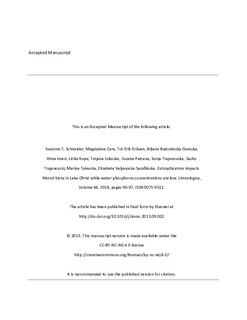| dc.contributor.author | Schneider, Susanne Claudia | |
| dc.contributor.author | Cara, Magdalena | |
| dc.contributor.author | Eriksen, Tor Erik | |
| dc.contributor.author | Goreska, Biljana Budzakoska | |
| dc.contributor.author | Imeri, Alma | |
| dc.contributor.author | Kupe, Lirika | |
| dc.contributor.author | Lokoska, Tatjana | |
| dc.contributor.author | Patceva, Suzana | |
| dc.contributor.author | Trajanovska, Sonja | |
| dc.contributor.author | Trajanovski, Sasho | |
| dc.contributor.author | Talevska, Marina | |
| dc.contributor.author | Sarafiloska, Elizabeta Veljanoska | |
| dc.date.accessioned | 2018-11-05T12:47:17Z | |
| dc.date.available | 2018-11-05T12:47:17Z | |
| dc.date.created | 2014-05-09T09:49:36Z | |
| dc.date.issued | 2014 | |
| dc.identifier.citation | Limnologica. 2014, 44, 90-97. | nb_NO |
| dc.identifier.issn | 0075-9511 | |
| dc.identifier.uri | http://hdl.handle.net/11250/2570988 | |
| dc.description.abstract | Eutrophication has traditionally been measured as increased phosphorus concentrations. In some lakes, however, such as transboundary Lake Ohrid situated between Macedonia and Albania, pelagic phosphorus concentrations are low, in spite of known sources of nutrient input. We assumed that littoral biota may be more responsive to phosphorus load than water chemistry, and studied nearshore water chemistry, macrophytes, diatoms and macroinvertebrates at 30 sites around the lake, analyzing functional groups as well as standard eutrophication metrics. We hypothesized that the incorporation of nutrients into benthic biomass will conceal correlations between water phosphorus concentrations and biological eutrophication metrics, but that analysis of functional groups in addition to eutrophication metrics may help draw a plausible picture of how phosphorus is transferred through the food web.
Water total phosphorus concentrations in the Lake Ohrid littoral were generally low, while all three analyzed organism groups indicated at least some degree of eutrophication. This shows that littoral biota are more sensitive indicators of nutrient input than hydrochemistry. The abundance of the benthic alga Cladophora sp. correlated positively with water total phosphorus concentrations, indicating that P-loading at local scales may be an important driver of Cladophora biomass. In contrast, none of the biotic metrics (macrophyte index, diatom index, and macroinvertebrate ICM) correlated with ambient water P-concentrations. We argue that this is not a sign of poorly working biological metrics, but a consequence of ecosystem processes in the lake littoral. Analysis of macrophyte and benthic algae abundance, and macroinvertebrate feeding types together with the biotic metrics suggests a meso- to slightly eutrophic littoral ecosystem where nutrient supply is incorporated into macrophyte and benthic algae biomass, and transferred through the food web from benthic algae to grazers, and from macrophytes to shredders and gatherers. Macroinvertebrate filter feeders correlate negatively with water total phosphorus concentrations, suggesting they remove phosphorus from the water. Our results indicate that the combined use of classical biological eutrophication metrics and functional groups may be a way to not only distinguish between oligotrophic and eutrophic ecosystems, but in addition give information as to whether or not nutrient input and nutrient removal in an ecosystem are balanced. This may eventually also give information about ecosystem functioning and ecosystem stability, and thus provide a basis for the development of “second generation” metrics for ecosystem assessment. | nb_NO |
| dc.language.iso | eng | nb_NO |
| dc.publisher | Elsevier | nb_NO |
| dc.rights | Attribution-NonCommercial-NoDerivatives 4.0 Internasjonal | * |
| dc.rights.uri | http://creativecommons.org/licenses/by-nc-nd/4.0/deed.no | * |
| dc.title | Eutrophication impacts littoral biota in Lake Ohrid while water phosphorus concentrations are low | nb_NO |
| dc.title.alternative | Eutrophication impacts littoral biota in Lake Ohrid while water phosphorus concentrations are low | nb_NO |
| dc.type | Journal article | nb_NO |
| dc.type | Peer reviewed | nb_NO |
| dc.description.version | acceptedVersion | nb_NO |
| dc.source.pagenumber | 90-97 | nb_NO |
| dc.source.volume | 44 | nb_NO |
| dc.source.journal | Limnologica | nb_NO |
| dc.identifier.doi | 10.1016/j.limno.2013.09.002 | |
| dc.identifier.cristin | 1131965 | |
| cristin.unitcode | 7464,30,19,0 | |
| cristin.unitname | Ferskvannsøkologi | |
| cristin.ispublished | true | |
| cristin.fulltext | postprint | |
| cristin.qualitycode | 1 | |

